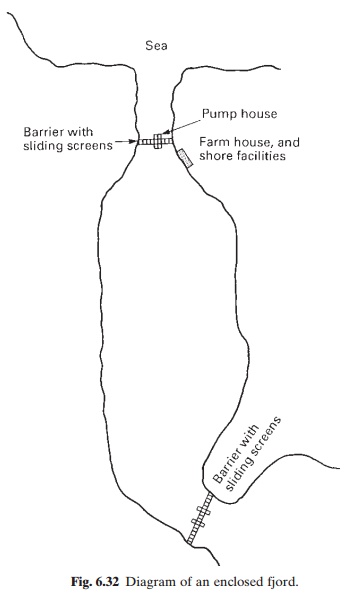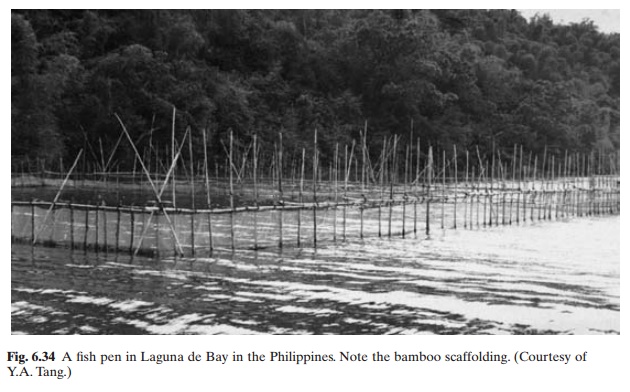Chapter: Aquaculture Principles and Practices: Design and Construction of Aquafarms
Pens and enclosures - Design and Construction of Aquafarms
Pens and enclosures
Pens and enclosures can in some ways be considered as transitional
structures between ponds and cages, in so far as environmental and stock
control are concerned. While enclosures or pens continue to be used in the
culture of yellowtail in Japan, milkfish in the Philippines and salmon in
Norway, attempts to introduce these systems have not met with much success in
many other countries. This can probably be ascribed to the difficulties in the
use of intensive techniques and in some cases the rather high costs of
embankments and water management, such as through pumping. Experience seems to
indicate that the success of enclosures for culture depends to a large extent
on the hydrological conditions of the site. The design of the structures and
operational procedures have to be based on adequate knowledge of water quality,
floods, waves and currents, prevalence of predatory animals, etc.
Probably the simplest and relatively most efficient type of enclosure
used for aquaculture is the one formed by damming a bay, cove, fjord or arm of
the sea, estuary or river (fig. 6.32). Sites are selected where the barriers
can be constructed across narrow sections, or channels, in order to reduce
costs and increase the ease of operation. Most of the perimeter of the
enclosure is formed by the natural shoreline.
When the blind end of a water area is enclosed, there may be only one or
one series of barriers, but in enclosures that permit direct flow-through there
may be two series of barriers: one upstream and another downstream. The dams
are constructed with stones, earth or concrete

depending on the availability of materials and exposure of the site to
storms and other natural disasters. They hold screens consisting of vertical
aluminum or galvanized metal bars, with about 1 cm gaps between them to allow
free flow of water. The screens, which are removable, can be located in the
concrete by moulded guideways. Two guideways are provided, one behind the other
for each screen, to enable a duplicate to be placed in position before removal
for cleaning. The screens prevent the escape of the fish stock. For proper
manage ment these enclosures have to be relatively small (2–7 ha), although
there are much larger enclosures in Japan, measuring up to 120 ha or more,
which should strictly be called ranches or reserves rather than farms. The
depth of water in different portions of the enclosure differs and the
circulation of water in the deepest parts may be insufficient to prevent the
accumulation of waste and organic matter, giving rise to oxygen depletion in
parts of the enclosure. Suction pumps have been used successfully for removing
such accumulations and additional flow-through has been created by propellers
mounted on floats. Obviously this increases the cost of operation.
Another type of enclosure or pen is the one formed by net barriers to
partition off areas of an open water body, such as the intertidal areas of the
sea or foreshore areas of lakes and reservoirs. Different designs of enclosures
have been constructed. But, generally, the enclosure is formed on one side by
the shore and on the other three by a wall of nylon netting hung from poles
driven into the sea. In many such enclosures, concrete or stone walls (about 3
m wide) are built on each side where it joins the shore, to provide adequate
support for the net. Around the rest of the perimeter, heavy posts of
impregnated timber or concrete piles are driven into the bed (by at least about
3 m), extending for about 2 m out of the water at all times (during floods and high
tide). Net barriers may be hung from steel cables strung between the poles or
the concrete or steel piles. To prevent the lateral movements of these piles
some are anchored fore and aft, to large anchor blocks using strong steel
cables. The nets are generally made of knotless nylon netting material. In some
cases, two walls of netting are used, the outer one to protect the enclosure
from floating debris and to prevent the escape of fish if the inner wall gets
damaged. However, this has been found to be a hindrance to free flow-through of
water and now in most enclosures only one net wall is used. Though not so
common as nylon nets, galvanized wire mesh or chain links are also being used
as barriers. At the bottom of the poles or pilings under water, the net barrier
is fixed by a rope along the sea bed for about 1 m, until it terminates in a
lead line. Normally the net embeds itself in the sand or silt at the bottom,
forming a good seal. As a
further precaution to prevent escape of fish, heavy rubble may be piled
at the bottom of the net or in some cases a net bottom may be provided.
A unique system of pen culture has developed in the shallow eutrophic
Laguna de Bay in the Philippines and in lakes in China. Using bamboo
scaffolding, enclosures of different sizes have been made in the lakes (fig.
6.33). Because of the shallow nature of the lakes, enclosures can be fairly
easily constructed. The average depth of Laguna de Bay at low water is only 3 m
and at high water 5 m. The netting is taken above the surface to prevent the
escape of fish by jumping (fig. 6.34).An improved floating net enclosure has
been developed, where the net enclosure is held in place by concrete block
sinkers (about 500 kg in weight), with a series of small weight on the foot
rope which is secured to a chain link between the sinkers. The net is kept
afloat by floats attached to the head-ropes. There is a horizontal net at the
top of the enclosure to prevent fish from jumping. To spread the load exerted
by water movement and wave action, a latticework of nylon rope is provided. The
enclosures are generally assembled on land, then taken to the site on barges
where they are installed by attaching them to the sinkers. Such floating
enclosures are now used in lakes for tilapia and milkfish. It is reported that
a similar system of pen culture of the giant fresh-water prawn has developed in
the Songkhla Lake in Thailand. Several circular pens consisting of a bamboo
framework and perlon nets have been built in the fresh-water portion of the
lake by small-scale farmers.


Related Topics